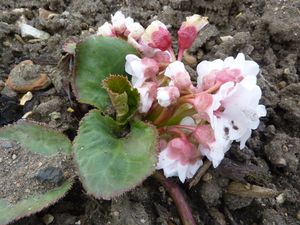Note: This is a project under development. The articles on this wiki are just being initiated and broadly incomplete. You can Help creating new pages.
Bergenia ligulata - Asmabhedaka
Bergenia ligulata Paashaanbhed, Prashanbheda, and other spellings in Ayurveda Indian traditional medicine is a plant belonging to the family Saxifragaceae and the genus Bergenia. The plant is mostly found in temperate Himalayas from Kashmir to Bhutan and in Khasia hills at 15,00 meter altitude.
Uses
Teething troubles, Ear pain, Intestinal parasites, Cuts, boils, wounds, burns, Dysentery, Fever, Cough.
Parts Used
Chemical Composition
Bergenia ligulata contains A phenolic compound bergenin and afzelechin, a type of flavan-3-ol.[1]
Common names
| Language | Common name |
|---|---|
| Kannada | Alepgaya, Hittaga, Hittulaka |
| Hindi | Dakachru, Pakhanabhed |
| Malayalam | Kallurvanchi,Kallurvanni |
| Tamil | Sirupilai |
| Telugu | Kondapindi, Telanurupindi |
| Marathi | NA |
| Gujarathi | NA |
| Punjabi | NA |
| Kashmiri | NA |
| Sanskrit | Ashmabheda,Nagbhita |
| English |
Habit
Identification
Leaf
| Kind | Shape | Feature |
|---|---|---|
| ovate rounded | Large rounded basal leaves with untoothed bristly margins |
.[2]
Flower
| Type | Size | Color and composition | Stamen | More information |
|---|---|---|---|---|
| Unisexual | 1.5-2.5 cm long | white–violet | with 5 petals | Sepal cup is hairless with blunt sepals |
Fruit
| Type | Size | Mass | Appearance | Seeds | More information |
|---|---|---|---|---|---|
| 7–10 mm (0.28–0.4 in.) long pome | s | {{{6}}} |
Other features
List of Ayurvedic medicine in which the herb is used
- Vishatinduka Taila as root juice extract
Where to get the saplings
Mode of Propagation
How to plant/cultivate
The more common species of Aconitum are generally those cultivated in gardens, especially hybrids. They typically thrive in well-drained evenly moist garden soils like the related hellebores and delphiniums, and can grow in the shade of trees.[3]
Commonly seen growing in areas
Photo Gallery
References
External Links
- Ayurvedic Herbs known to be helpful to treat Teething troubles
- Ayurvedic Herbs known to be helpful to treat Ear pain
- Ayurvedic Herbs known to be helpful to treat Intestinal parasites
- Ayurvedic Herbs known to be helpful to treat Cuts
- Ayurvedic Herbs known to be helpful to treat boils
- Ayurvedic Herbs known to be helpful to treat wounds
- Ayurvedic Herbs known to be helpful to treat burns
- Ayurvedic Herbs known to be helpful to treat Dysentery
- Ayurvedic Herbs known to be helpful to treat Fever
- Ayurvedic Herbs known to be helpful to treat Cough
- Herbs with Root used in medicine
- Herbs with rhizomes used in medicine
- Herbs with leaves used in medicine
- Herbs with common name in Kannada
- Herbs with common name in Hindi
- Herbs with common name in Malayalam
- Herbs with common name in Tamil
- Herbs with common name in Telugu
- Herbs with common name in Sanskrit
- Habit - Herb
- Index of Plants which can be propagated by Seeds
- Index of Plants which can be propagated by Tuber segment
- Herbs that are commonly seen in the region of western Himalayas
- Herbs that are commonly seen in the region of open woodland
- Herbs that are commonly seen in the region of moisty soil area
- Herbs




